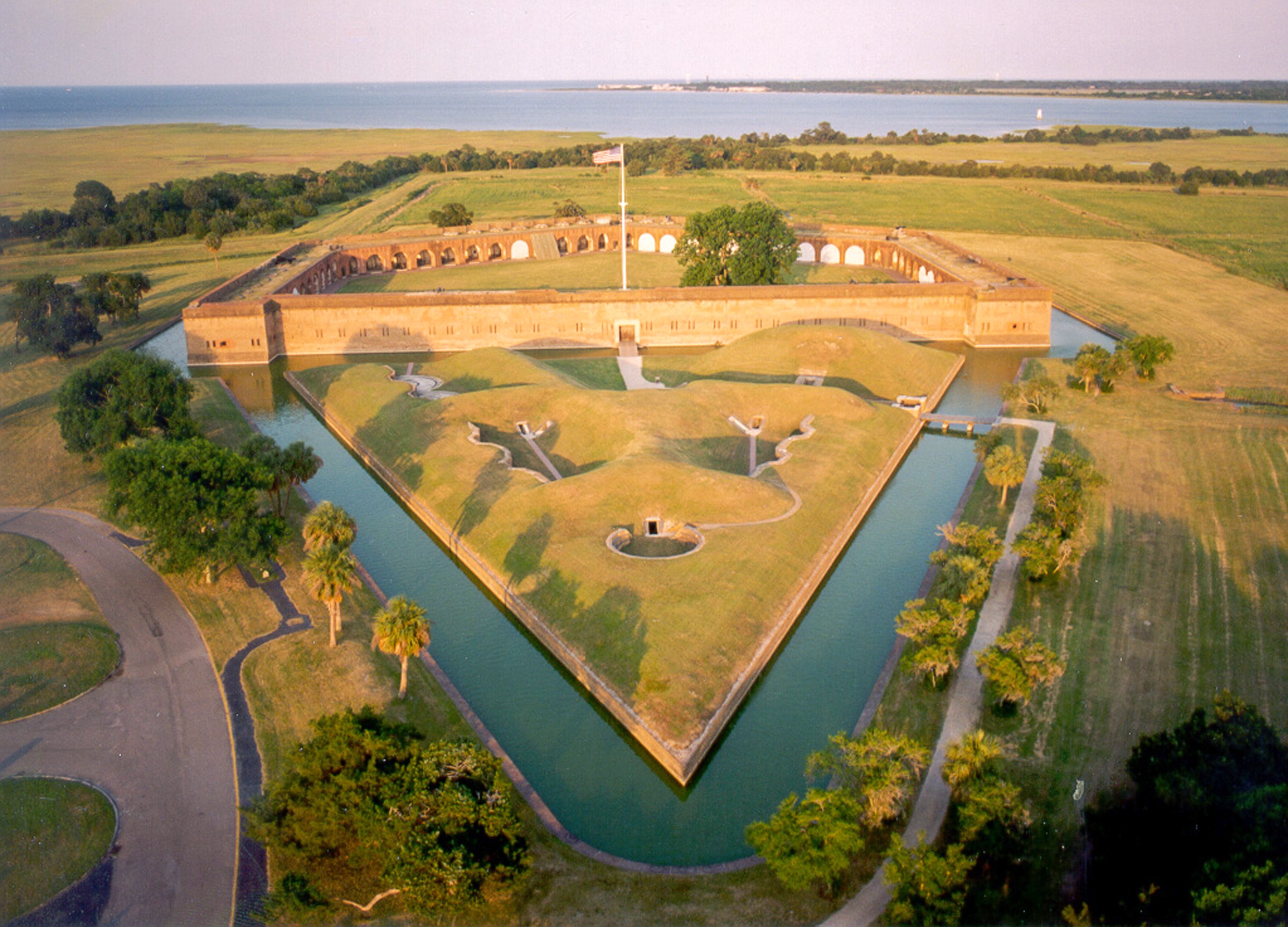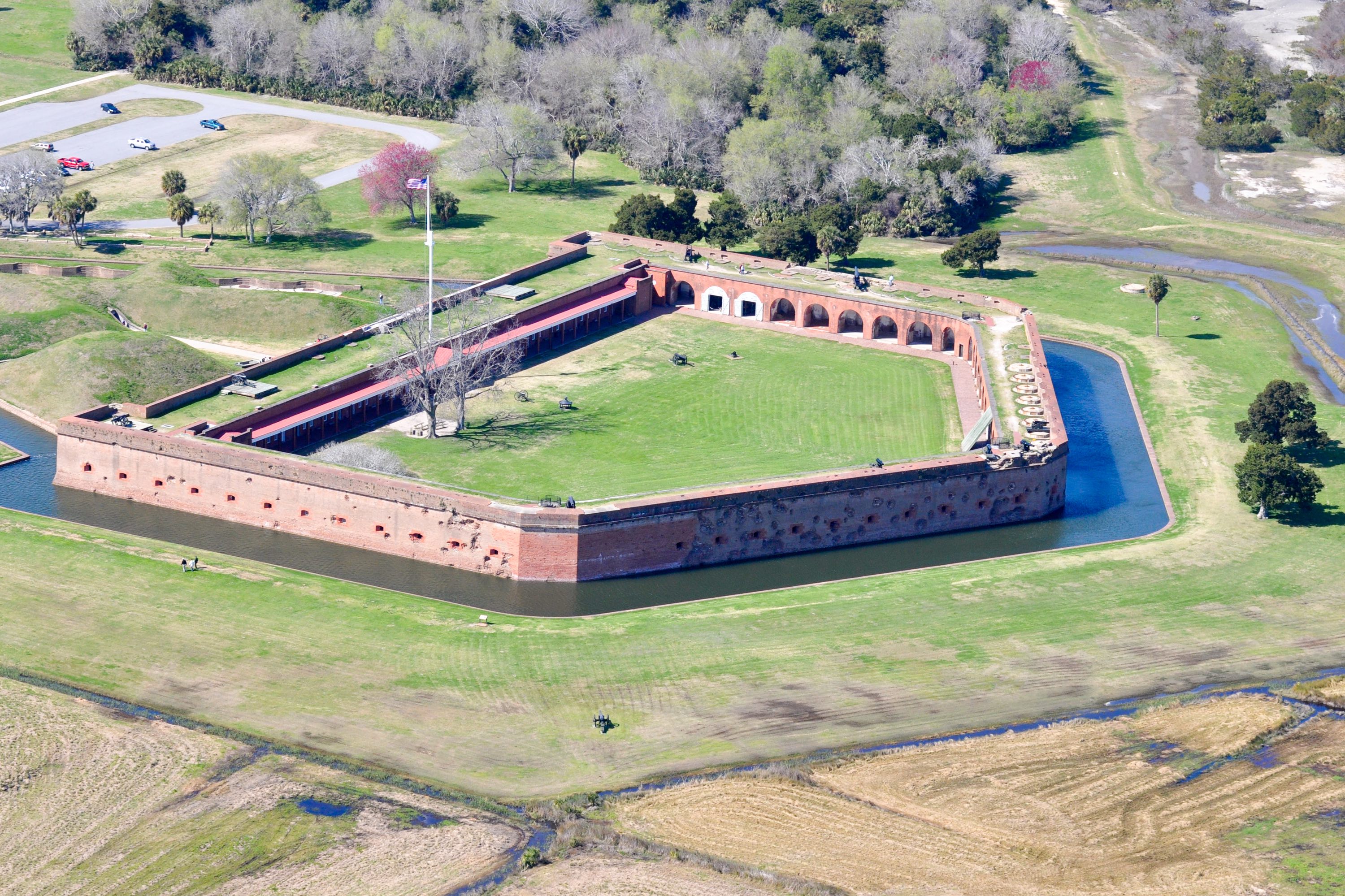
Where Stone Met Steel: Fort Pulaski and the Dawn of Modern Warfare
Cockspur Island, a low-lying sliver of land in the marshy expanse of coastal Georgia, guards the mouth of the Savannah River. For generations, this strategic choke point was deemed vital to the defense of one of the South’s most important port cities. Here, towering above the sea grass and shifting sands, stands Fort Pulaski National Monument – a colossal masonry fortress, a testament to 19th-century engineering prowess, and the silent stage for a battle that irrevocably changed the face of warfare. Its story is not just one of siege and surrender, but of a pivotal moment when the age of the "impenetrable" fortress crumbled under the relentless might of a new, revolutionary technology.
From its very inception, Fort Pulaski was envisioned as an unassailable bastion. Part of the ambitious Third System of coastal fortifications initiated after the War of 1812, its construction began in 1829 and spanned 18 years, costing nearly a million dollars – a staggering sum for the era. Built on a foundation of more than 25 million bricks, driven deep into the marshland on immense timber pilings, the fort was a masterpiece of military architecture. Its five sides, each approximately 160 feet long, rose 32 feet above the water, encircled by a wide, deep moat. Its walls, up to seven feet thick, were designed to withstand the most powerful smoothbore cannon of the day, deflecting solid shot with their sloped surfaces. The renowned engineer Lieutenant Robert E. Lee, then a young West Point graduate, spent 18 months supervising much of the early construction, pioneering innovative techniques to stabilize the marshy ground – a detail that adds a layer of poignant irony to the fort’s eventual fate.
The fort’s name honored Count Casimir Pulaski, a Polish nobleman and Revolutionary War hero who died fighting for American independence during the Siege of Savannah in 1779. It was a fitting tribute to a warrior, yet few could have imagined that the fort bearing his name would, less than two decades after its completion, become the symbol of a bygone era of warfare.

When Georgia seceded from the Union in January 1861, Fort Pulaski, like many federal installations in the South, was swiftly seized by Confederate forces. Garrisoned by a small contingent of Georgia volunteers under the command of Colonel Charles H. Olmstead, it became a crucial part of the Confederacy’s coastal defense, shielding Savannah from Union naval incursions. The prevailing wisdom, echoed by military strategists on both sides, held that the fort was impregnable. Its isolation on Cockspur Island, surrounded by miles of tidal marsh, seemed to guarantee its safety from land-based assault. Naval bombardment, it was believed, would simply bounce off its massive brick walls.
This deeply held belief was about to be shattered. The Union high command, recognizing the strategic importance of Savannah, sought to capture or neutralize Fort Pulaski. General Quincy A. Gillmore, a brilliant and audacious engineer who had studied under Robert E. Lee at West Point, was tasked with the daunting challenge. Unlike previous commanders who might have considered a direct naval assault, Gillmore proposed a radical, almost heretical, strategy: bombard the fort from land.
The logistical challenges were immense. Gillmore’s plan required dragging heavy artillery pieces, including a new and relatively untested weapon – the rifled cannon – across miles of treacherous marshland, often under cover of darkness and hidden from Confederate view. This monumental effort, undertaken by Union forces under the command of Brigadier General David Hunter, involved constructing earthen batteries on nearby Tybee Island, some 1,600 to 2,200 yards (approximately one to one-and-a-quarter miles) from the fort. These batteries, named after prominent Union figures, were carefully camouflaged, their construction a grueling testament to engineering and endurance.
The rifled cannon was the game-changer. Unlike the smoothbore cannons that had dominated battlefields for centuries, firing spherical projectiles with limited accuracy and penetrating power, rifled guns had spiral grooves inside their barrels. These grooves imparted a spin to an elongated projectile, vastly improving its accuracy and range, and crucially, its ability to penetrate solid objects. Gillmore was convinced that these new weapons – specifically the 30-pounder Parrott rifle and the 42-pounder James rifle – could do what smoothbores could not: breach the mighty brick walls of Fort Pulaski. His superiors, however, were skeptical, clinging to the doctrine that masonry forts were immune to land-based artillery at such a distance.
On April 10, 1862, at precisely 8:00 AM, the Union bombardment began. For the Confederates inside Fort Pulaski, the initial hours were a mix of confidence and mild irritation. The smoothbore cannonballs, though numerous, often struck the fort at glancing angles, or simply embedded themselves in the thick walls with little structural damage. Colonel Olmstead observed the shelling, confident that his position was secure.
However, as the day wore on, a chilling new reality began to emerge. The rifled projectiles, launched with terrifying accuracy from Gillmore’s distant batteries, behaved differently. Instead of bouncing, they struck with concussive force, their pointed ends burrowing into the brickwork, pulverizing mortar, and cracking bricks. The concentrated fire of these new weapons began to target a specific section of the fort’s southeast angle – the "pan coupé" – where two walls met.
"The effect of the rifled projectiles was a surprise," Olmstead later wrote, "they tore out large masses of masonry, making excavations in the wall… that increased in size and depth with fearful rapidity." The "fearful rapidity" was key. Unlike the relatively slow, blunt damage of smoothbores, the rifled guns were performing precision surgery on the fort’s defenses. Each impact was a deafening explosion, showering the interior with brick dust and debris, shaking the very foundations of the structure. The garrison, numbering around 385 men, huddled in the casemates, the reverberations of the shells a constant, terrifying companion.
Throughout the night of April 10th and into the morning of April 11th, the bombardment continued relentlessly. Over 4,700 projectiles rained down on Fort Pulaski. By mid-morning on the 11th, a gaping breach, estimated to be seven feet wide and ten feet deep, had been torn into the southeast wall, directly in line with the fort’s main powder magazine. Through this gaping hole, Union shells could now penetrate directly into the heart of the fort, threatening to detonate the stored gunpowder and annihilate the garrison.

The situation for the Confederates was desperate. With the magazine exposed, surrender was the only viable option to prevent a catastrophic loss of life. At 2:30 PM on April 11, 1862, Colonel Olmstead raised the white flag. The "impregnable" Fort Pulaski had fallen after just 30 hours of bombardment.
The Battle of Fort Pulaski was, in many ways, a microcosm of the larger technological revolution sweeping through the Civil War. It was a stark, undeniable demonstration that the age of the masonry fort was over. "The result of this bombardment," General Gillmore famously declared, "must cause a change in the construction of fortifications, for now, it is demonstrated that a well-directed fire of rifled guns can overcome a strong masonry fort." The implications were profound. Military engineers around the world quickly took note, recognizing that future defensive structures would need to be built with earthworks and concrete, not brick and stone, to withstand the destructive power of modern artillery.
For the remainder of the war, Fort Pulaski served as a Union prison, primarily for Confederate political prisoners and high-ranking officers. Conditions were harsh, particularly during the "Immortal Six Hundred" episode in 1864, when 600 Confederate officers were held under severe conditions in retaliation for the treatment of Union prisoners elsewhere. After the war, the fort gradually fell into disrepair, battered by neglect, storms, and the sheer passage of time.
It wasn’t until the early 20th century that efforts began to preserve this significant historical site. In 1924, Fort Pulaski was designated a National Monument, and extensive restoration work began under the National Park Service. Today, visitors can walk through the massive archways, explore the casemates, and stand on the parade ground, experiencing the echoes of its pivotal past. The visible scars of the bombardment, particularly the repaired breach in the southeast wall, remain a tangible reminder of the battle’s ferocity and its revolutionary impact.
Fort Pulaski stands not merely as a relic of the Civil War, but as a monumental classroom. It teaches us about the ingenuity of military engineers, the courage of soldiers on both sides, and the relentless march of technological innovation. It is a place where the confidence of the past met the destructive force of the future, forever altering the landscape of warfare and leaving an enduring legacy etched in stone and iron. The "impenetrable" fortress, once a symbol of security, became a powerful testament to the inevitability of change, a silent sentinel guarding not just the Savannah River, but a crucial turning point in military history.


